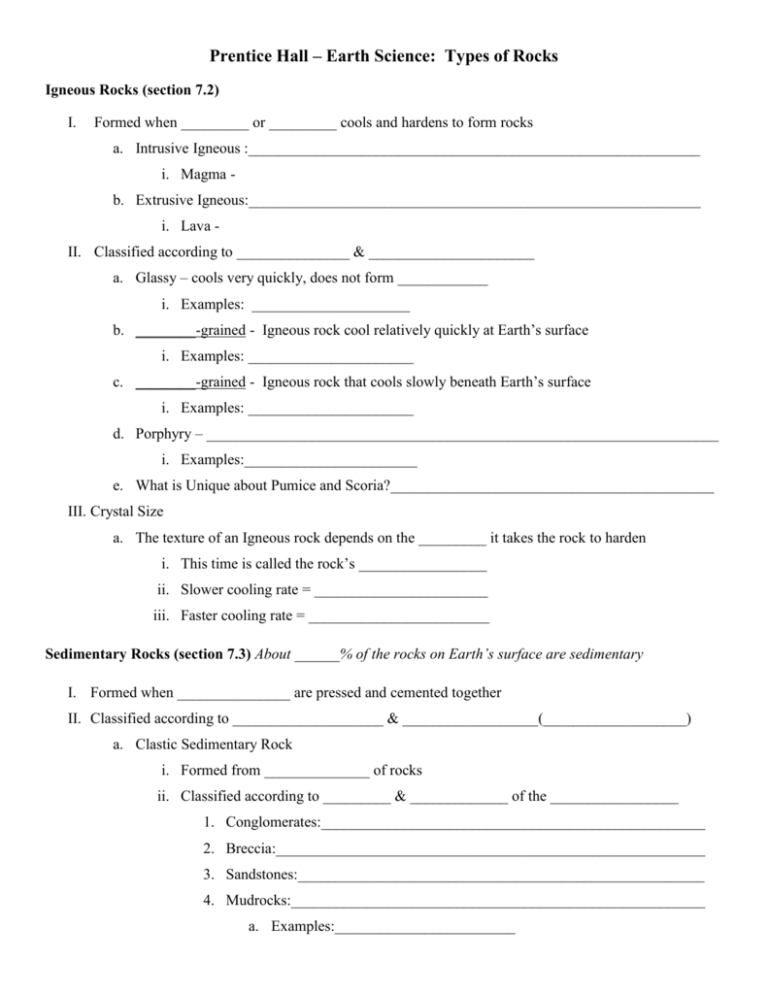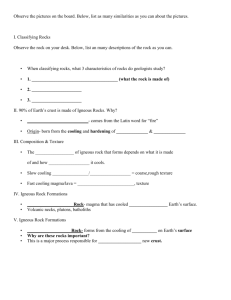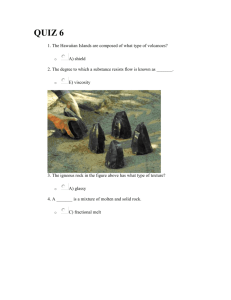Prentice Hall – Earth Science: Types of Rocks Igneous Rocks
advertisement

Prentice Hall – Earth Science: Types of Rocks Igneous Rocks (section 7.2) I. Formed when _________ or _________ cools and hardens to form rocks a. Intrusive Igneous :____________________________________________________________ i. Magma b. Extrusive Igneous:____________________________________________________________ i. Lava - II. Classified according to _______________ & ______________________ a. Glassy – cools very quickly, does not form ____________ i. Examples: _____________________ b. ________-grained - Igneous rock cool relatively quickly at Earth’s surface i. Examples: ______________________ c. ________-grained - Igneous rock that cools slowly beneath Earth’s surface i. Examples: ______________________ d. Porphyry – ____________________________________________________________________ i. Examples:_______________________ e. What is Unique about Pumice and Scoria?___________________________________________ III. Crystal Size a. The texture of an Igneous rock depends on the _________ it takes the rock to harden i. This time is called the rock’s _________________ ii. Slower cooling rate = _______________________ iii. Faster cooling rate = ________________________ Sedimentary Rocks (section 7.3) About ______% of the rocks on Earth’s surface are sedimentary I. Formed when _______________ are pressed and cemented together II. Classified according to ____________________ & __________________(___________________) a. Clastic Sedimentary Rock i. Formed from ______________ of rocks ii. Classified according to _________ & _____________ of the _________________ 1. Conglomerates:___________________________________________________ 2. Breccia:_________________________________________________________ 3. Sandstones:______________________________________________________ 4. Mudrocks:_______________________________________________________ a. Examples:________________________ b. Organic Rocks (Nonclastic) i. Formed directly or indirectly from _________________________________________ 1. Examples:__________________________________________ c. Chemical Rocks (Nonclastic) i. Formed by __________________________ that do not involve living organisms ii. Evaporites:_____________________________________________________________ 1. Examples:________________________________ Metamorphic Rocks (section 7.4) I. Formed when already existing rocks _____________________________________________________ ________________________________________________________________________________ ________________________________________________________________________________ II. Types of Metamorphism a. Contact:______________________________________________________________________ _____________________________________________________________________________ b. Regional:_____________________________________________________________________ _____________________________________________________________________________ III. Classified by texture a. Foliated:______________________________________________________________________ i. Tend to break along layers/bands ii. Examples: slate from_________ and gneiss from _________ b. Unfoliated i. Do not have ____________________________ & do not break ____________________ ii. Examples:______________ from sandstone and ____________ from limestone








